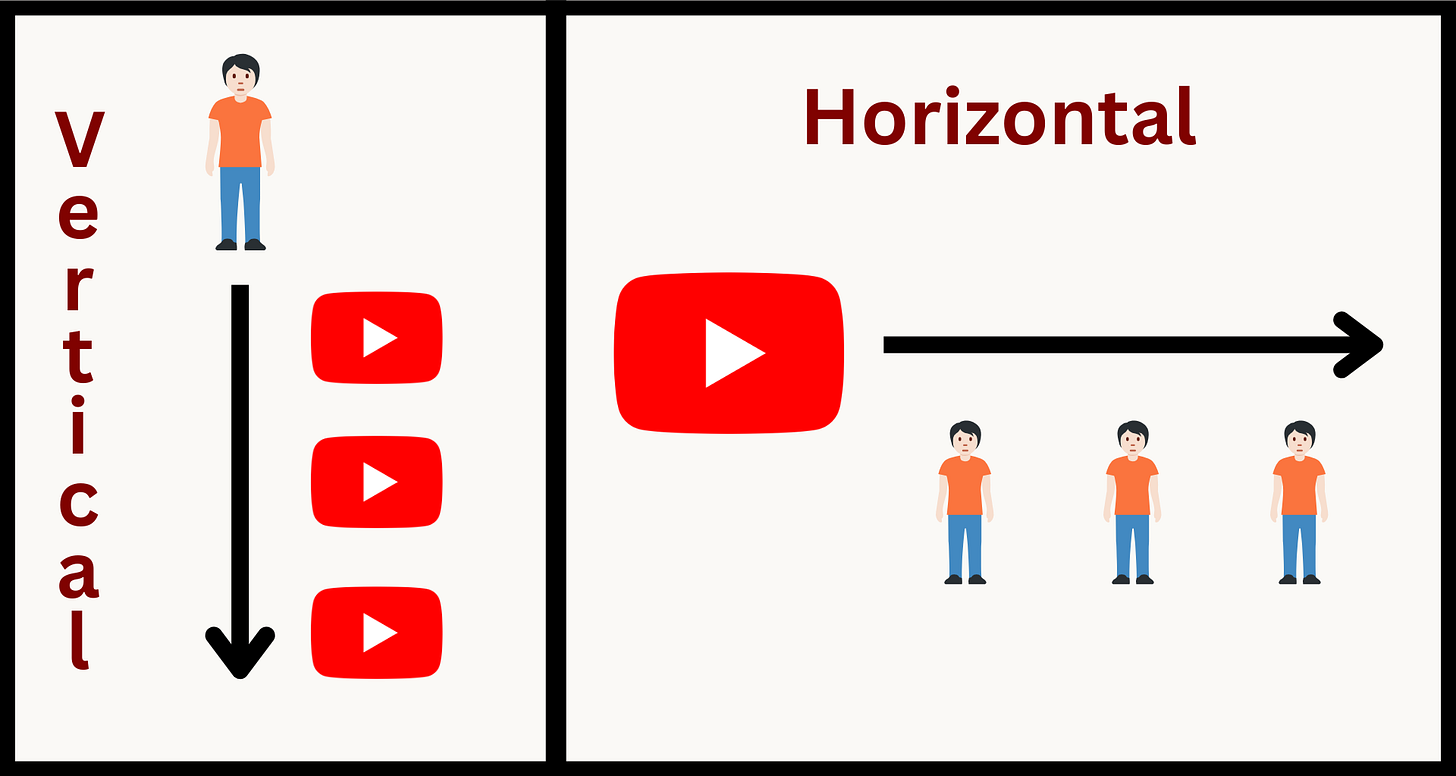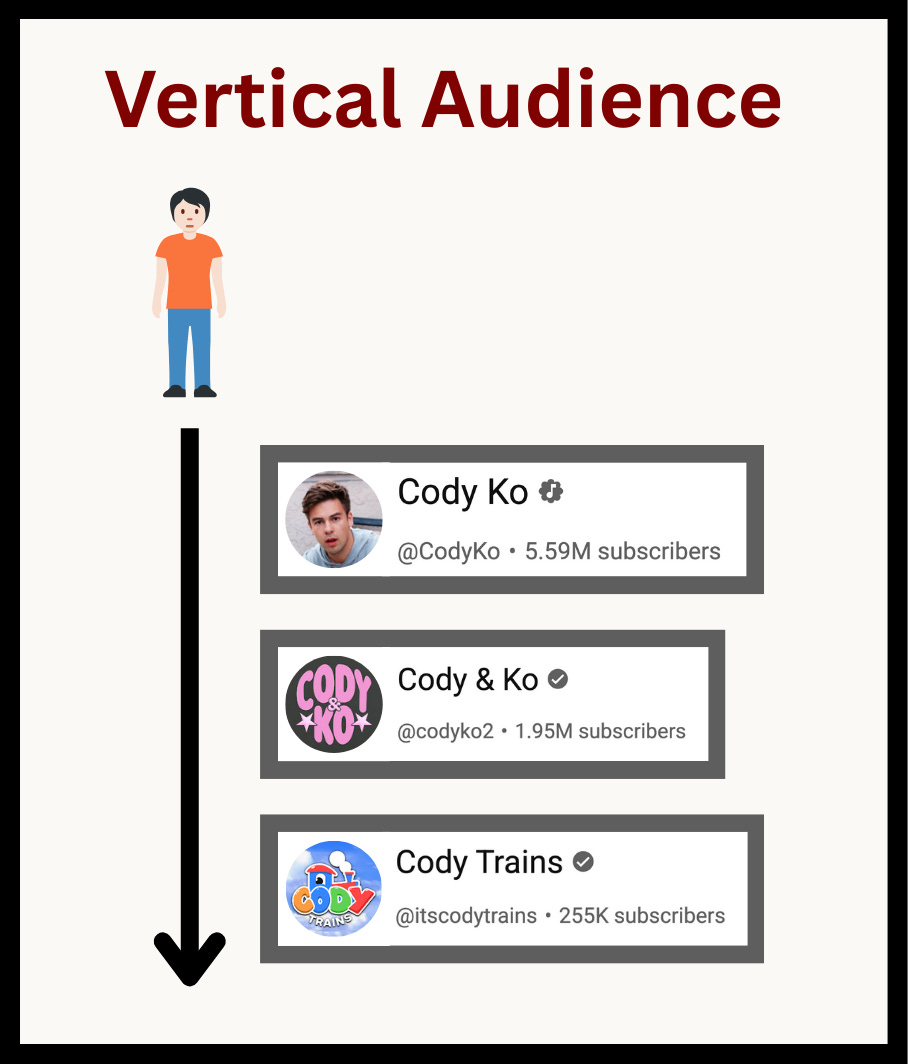2 Models of Creator Growth: Which is worth billions?
Top creators can either deepen their existing audience or expand into new audiences.
I believe creator-led businesses will go public in my lifetime. This is their key to expand.
Just like businesses, creators have market sizes: how many viewers can be interested in their work? New creators have room to grow. Top creators have nearly saturated their YouTube audience.
There are two ways for top creators to continue to grow their audience:
Vertical: more views from current audience
Horizontal: expand into new audiences
Let’s explore the differences, what kind of creator suits each, and which one truly allows for billion-dollar scale.
Case Study #1: Cody Ko (Vertical)
Cody Ko has three channels:
Cody Ko: commentary and reaction videos
Cody & Ko: livestream highlights
Cody Trains: fitness vlogs
One viewer likely watches all three channels. Since Cody is a personality-based creator, viewers follow him wherever he goes. One viewer = multiple views.
The comments already beg Cody to post more content:

Since Cody is personality-based, his value proposition is taste and entertainment. Cody’s just one person. So when he maxes out people who jive with his personality, he can’t really change his personality to expand to new audiences. To get more views, he needs more loyalty from his existing audience.
Case Study #2: Theorist Media (Horizontal)
Theorist Media has four channels:
The Game Theorists: video game conspiracies (est. 2009)
The Film Theorists: film secrets (est. 2015)
The Food Theorists: fast food myths (est. 2020)
The Style Theorists: fashion trends (est. 2023)
It’s hard to imagine one viewer being interested in all four of these channels equally. When The Game Theorists capped out their video game audience, it made sense to spread to other niches.
Viewers are loyal to the topic, not to the creator. The comments are thoughtful:

The Food Theorists found people who are already curious about food. They delivered them the best content to satisfy this curiosity. Theorist Media has perfected this edutainment format from data on 2,000+ videos.
Jubilee follows a similar horizontal strategy. Though Jubilee has one channel, it posts topics ranging from politics, religion, gender, sexuality, race, and more. I don’t watch everything. I choose to view what interests me. I’m loyal to Jubilee’s quality and format, not Jubilee as a brand.
Which Strategy Is “Better”?
It might seem like vertical audiences build a better moat. Viewers are loyal to a creator. But at least for where the creator economy is now, a scaled production system and talent attraction (with horizontal) is a great moat, too.
According to a 2024 interview with Colin & Samir, Theorist Media had 22 full-time employees and another 20 freelancers. Each channel has its own creative director, who spent years with the brand to know Theorist’s style, format, and feel.
Even MrBeast admits that creator talent is hard to find. A-Player employees have a perfect trifecta: technically skilled, algorithm nerds, and fluent in pop culture.
“You’re either an A-Player, B-Player, or C-Player. There is only room in this company for A-Players. A-Players are obsessive, learn from mistakes, coachable, intelligent, don’t make excuses, believe in Youtube, see the value of this company, and are the best in the goddamn world at their job.”
> How to Succeed in MrBeast Production (Document)
In the interview, Samir predicted that while labor is scarce currently in the creator economy, it will become more available in a few years. Top talent may stop wanting to become creators themselves and instead work within established brands. Not everyone wants to be a founder/operator.
Theorist Media likely shares a team across all four channels. An editor trained once can repeat high-quality, brand-feel videos. Stephanie Patrick mentioned that employees “have drunk the Kool-Aid” of Theorist’s mission and are motivated to work hard.
Theorist has the expertise. They know what works on YouTube. They can scale their format to any niche. It’ll be difficult for competitors to gain access to the talent, data, and brand that Theorist is compounding.
Monetization
Vertical audiences can monetize via direct-to-consumer. Loyal viewers are willing to purchase higher-ticket products like merchandise, physical products, or live experiences.
Horizontal audiences can monetize via advertising. With audiences concentrated across specific segments, brand partnerships and niche products are big opportunities.
Case Study #3: MrBeast (Matrix)
MrBeast follows a matrix approach, that is primarily horizontal.
Horizontal: dubbing to 23 languages, “Ages 0-100” relatability, Amazon Prime Video show
Vertical: MrBeast gaming, Beast Reacts, Beast Philanthropy, Beast Animations, Beast Games
MrBeast’s monetization is also hybrid. He’s had success with brand partnerships like Shopify, Amazon, and DoorDash, as well as selling his own products like merchandise, Feastables, Lunchly, and Viewstats.
Looking Forward
Vertical audiences can build a solid, profitable business.
For creators looking to build the next Disney, I believe horizontal audiences are the key to expand.







